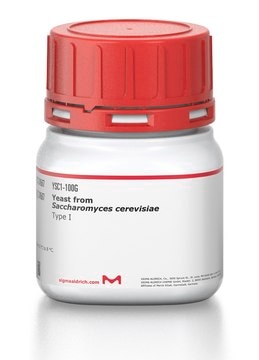YSC2
Yeast from Saccharomyces cerevisiae
Type II
Sinônimo(s):
(Bakers yeast)
Faça loginpara ver os preços organizacionais e de contrato
About This Item
Código UNSPSC:
12352202
NACRES:
NA.24
Produtos recomendados
fonte biológica
Saccharomyces cerevisiae
Nível de qualidade
tipo
Type II
forma
powder or solid
aplicação(ões)
food and beverages
microbiology
temperatura de armazenamento
2-8°C
Aplicação
Yeast from Saccharomyces cerevisiae has been used:
- in yeast sample preparation for tube-gel electrophoresis (TGE) fractionation
- as a diet supplement to study its effect on the utilization of food waste as a diet for grass carp
- for fermentation of miscanthus and the cellulose-rich extract samples to produce ethanol
Ações bioquímicas/fisiológicas
Saccharomyces cerevisiae is a unicellular fungus. Yeast from S. cerevisiae is the widely used yeast species in bread and sourdoughs. It is used to produce several fermented beverages (cider, beer, 85s, and wine) and distilled beverages (brandy, sake, vodka, and whisky). S. cerevisiae has better tolerance for fermentation stresses than any other yeast species. Hence, it is a preferred starter culture for industrial fermentation.
Atenção
Only approx. 10% will autolyze in aqueous buffer at 37 °C.
Nota de preparo
Fast dried to yield 90% active, viable yeast in a convenient solid form.
Código de classe de armazenamento
11 - Combustible Solids
Classe de risco de água (WGK)
WGK 3
Ponto de fulgor (°F)
Not applicable
Ponto de fulgor (°C)
Not applicable
Equipamento de proteção individual
Eyeshields, Gloves, type N95 (US)
Certificados de análise (COA)
Busque Certificados de análise (COA) digitando o Número do Lote do produto. Os números de lote e remessa podem ser encontrados no rótulo de um produto após a palavra “Lot” ou “Batch”.
Já possui este produto?
Encontre a documentação dos produtos que você adquiriu recentemente na biblioteca de documentos.
Os clientes também visualizaram
Sivasamy Sethupathy et al.
Frontiers in microbiology, 11, 584812-584812 (2020-11-17)
Indole and its derivatives have been shown to interfere with the quorum sensing (QS) systems of a wide range of bacterial pathogens. While indole has been previously shown to inhibit QS in Serratia marcescens, the effects of various indole derivatives
Margaret Clarke et al.
PloS one, 5(1), e8585-e8585 (2010-01-07)
The vacuolar H+-ATPase, or V-ATPase, is a highly-conserved multi-subunit enzyme that transports protons across membranes at the expense of ATP. The resulting proton gradient serves many essential functions, among them energizing transport of small molecules such as neurotransmitters, and acidifying
Lacrimioara Senila et al.
Molecules (Basel, Switzerland), 25(11) (2020-06-07)
In this paper, the production of a second-generation bioethanol from lignocellulosic vineyard cutting wastes was investigated in order to define the optimal operating conditions of the autohydrolysis pretreatment, chlorite delignification and simultaneous saccharification and fermentation (SSF). The autohydrolysis of vine-shoot
Eric J Kalivoda et al.
PloS one, 8(7), e71267-e71267 (2013-08-08)
Biofilm-related infections are a major contributor to human disease, and the capacity for surface attachment and biofilm formation are key attributes for the pathogenesis of microbes. Serratia marcescens type I fimbriae-dependent biofilms are coordinated by the adenylate cyclase, CyaA, and
Pretreatment of miscanthus using 1, 3-dimethyl-imidazolium methyl phosphonate (DMIMMPh) ionic liquid for glucose recovery and ethanol production
Hassan El-Sayed RE, et al.
Royal Society of Chemistry Advances, 5(75), 61455-61464 (2015)
Nossa equipe de cientistas tem experiência em todas as áreas de pesquisa, incluindo Life Sciences, ciência de materiais, síntese química, cromatografia, química analítica e muitas outras.
Entre em contato com a assistência técnica








